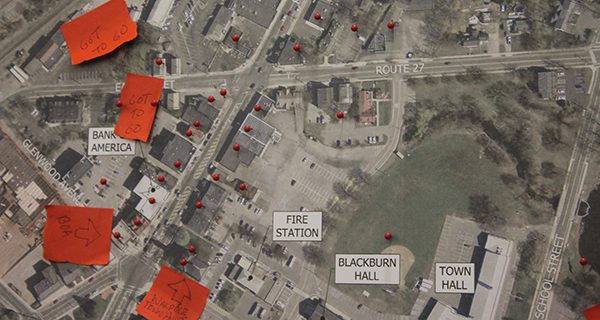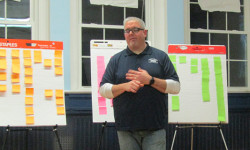[ccfic caption-text format="plaintext"]
By James Kinneen
Hometown Weekly Reporter
On Tuesday night, McCabe Enterprises and the Pare Corporation presented the findings of their study on economic development and parking in Walpole Center. Funded by a $20,000 community compact grant, the study sought to determine how downtown Walpole could be made more attractive to future generations, while recognizing current and possible parking and road issues.
Essentially, the study (which was initially delayed so it would include students going to school) found that Walpole is still a car-centric community dependent on public parking downtown, but that this needs to change.
Kathleen McCabe educated town business owners and citizens on the fact that due to the rise of online shopping, downtown businesses must shift from being transaction-based to experience based.
“Stores are shrinking because of the internet,” explained McCabe. “The growth of e-commerce is changing the types of stores that thrive downtown, so that there needs to be more of a focus on food, social gatherings and created experiences. A wine store might have a tasting so that it creates an experience, not just a transaction. Now if you only want a commercial interaction, you just go online.”
McCabe further spoke of young peoples’ desire for more walkable cities. After citing a graph of neighboring towns’ walkability ratings, she was quick to point out that walkability is a serious aid to modern businesses, not a nice thing to have to appear environmentally friendly. While residents expressed concerns over how many new residencies were being developed and how that would impact future parking, McCabe noted that younger people tend to drive far less than older generations, preferring walking or using ride-sharing apps like Uber and Lyft.
But she also acknowledged there are many simple improvements that could lead to better parking downtown. While their study showed there are often many available parking spots, it seemed clear that people were having trouble finding them. Simple fixes, like better street signs, might thereby limit the number of cars driving slowly and clogging the streets. Another idea suggested that if street lighting were better, people might be more willing to park further away; this idea is supported by the number of drivers who do so when the downtown area puts up its holiday lighting. One resident pointed out that the town fire department had a what he considered an unnecessary 33 spots dedicated to their employees.
Other improvements might take more work. When discussing the downtown area’s vacant lots, McCabe noted that vacant lots present a challenge, as there are no other businesses to piggyback off of, and that these days, small business owners want lots that are ready to be moved into immediately. Right now, many of the empty lots in downtown Walpole are simply not ready for occupancy.
The man who hired McCabe and Pare, Community Planning Director John Charbonneau, had worked with the company in the past and offered his own suggestion based off his time in other towns. “We have to start looking at the odd-shaped lots, the conical lots, maybe think about doing some lot sharing,” he said. “All the easy lots are taken, so businesses are going to have to get creative.”
While Charbonneau was talking about parking, the idea rings true for much of the future of downtown Walpole. In order to adapt to the future, towns need to shift from being car-based to more walkable, and stores need to move from transaction-based to experience-based.
To accomplish that, town governments and business owners are going to need to get a little bit creative.
























